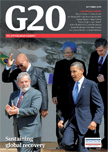

 |
 |
|

The Copenhagen Conference's Climate Change Challenge
By Lars Lokke Rasmussen, prime minister, Denmark
To download a low-resolution pdf, click here. (Be patient! It's 7.7 MB.)
In Copenhagen, negotiators need to mark the beginning of the reorganisation of the world economy to ensure the global temperature increase does not exceed 2°C
The challenge of Copenhagen is one that is unavoidable and manageable. The compelling evidence on climate change calls for action. In three months, participants at the United Nations meeting on climate change in Copenhagen must conclude a global climate change agreement that will set the terms for decisive and collective action on climate change for many years to come. The objective is clear and ambitious: the Copenhagen agreement must be comprehensive, fair and effective.
It is not an easy task. Participants are facing difficult negotiations. But let us focus on the positive developments. It is encouraging that leaders at the Major Economies Forum (MEF) recognised in July that climate change requires an extraordinary global response and acknowledged the need that the increase in global temperature should not exceed 2°C. This is the same objective to which the European Union has agreed. The G8 countries went one step further by declaring that they will work toward reducing emissions by 80 per cent in 2050. It is also encouraging that many countries have chosen to follow a low-carbon development path by adopting climate action plans.
There is momentum. However, countries still have to accelerate speed to succeed in Copenhagen and meet the 2°C objective.
The G20 summit in Pittsburgh is the next important step. The world’s economic crisis and climate are expected to be key issues there. G20 leaders can and must send a strong message on climate change financing and thereby bring vital input to the UN negotiations. All must oppose the risk of complacency, while combating the most severe economic crisis in a generation.
As leaders we must face the challenge of communicating the need for climate action. When you lose your job, the effect of the economic crisis on your everyday life is very direct and sudden. The effects of climate change on daily life may be much less apparent here and now; standing at the seashore you cannot see the sea level rising no matter the amount of scientific evidence. But without decisive action, the effects of climate change will be even more real, disruptive or devastating than those of the economic crisis. And while countries can engineer financial bailouts and economic stimulus packages, there is no such thing as a climate bailout if leaders fail to act now.
There can be no other way but to transform to low-carbon societies. It is crucial to exploit the opportunities offered by the green agenda. Transforming economies into a low-carbon growth path will offer new possibilities for technological development, production and employment. Countries typically spend as much as 5 per cent of gross domestic product or more on fossil fuels. A low-carbon transformation can free up these resources and let them be put to other uses. Some sectors will experience decline, but others will face new opportunities. There is no contradiction between ambitious climate change policies and sustained economic growth. Green growth is the future.
In December, Copenhagen must address five key issues: financing, mitigation, adaptation, technology, and principles on measurement, reporting and verification.
The provision of financing to underpin and enhance climate action in developing countries will be one key element of an agreement in Copenhagen.
The current international framework here is not up to scale and is unable to deliver. Substantial changes are needed, by jointly building a climate financing architecture that can deliver support at sufficient pace and scale. It must ensure effective matching between climate action and support and achieving the maximum climate effect of support delivered. In addition to international public support, there will be financial transfers stemming from international carbon trade and crediting mechanisms. To ensure both sufficient financial transfers and environmental integrity of the system, the existing international carbon market mechanisms will have to be reformed, inter alia by introducing a higher level of aggregation through a programme-based approach.
Many issues need to be settled before a climate financing architecture can become fully operational. These issues include governance, sources of funds, envisaged circumstances for matching actions and finance and for accessing funds, and channels and instruments for delivery. Contributors want confidence and assurance that funds are being used efficiently and effectively, while recipients want confidence and assurance about availability and accessibility of finance. An appropriate balance between these concerns must be found.
Furthermore, there must be a balance, acceptable to all parties, between action by industrialised countries and action by developing countries, the financial flows to developing countries and the actions in developing countries supported by these flows. The complexity of this negotiation is breathtaking.
Mitigation, emission targets, and pathways and abatement efforts will be a second core element of the Copenhagen agreement.
Industrialised countries must take the lead in achieving sizeable reductions in their emissions. In the mid term, the world must find common ground on targets. Concurrently we must work out the contribution of emerging economies and developing countries. Their efforts, while reflecting their individual national circumstances, must in the medium term achieve substantial deviation from ‘business as usual’ in their emissions.
While countries must acknowledge that there may be different paths to their final destination, they need to ensure that everyone is clearly and convincingly moving toward the same ambitious goal. Moreover, they need to ensure there is consistency between the pace they are setting and the planned arrival at the final destination.
To limit global warming to 2°C, global greenhouse gas emissions should peak no later than 2020 and be reduced by 50 per cent by 2050, compared to 1990.
Adaptation and technology are the third and fourth key elements in the Copenhagen agreement. Adapting to the climate change already occurring and that will occur notwithstanding mitigation efforts is inevitable. In particular, many poorer and vulnerable developing countries will be disproportionately affected. International support for their adaptation efforts is a necessary component in the Copenhagen agreement.
Accelerated development and transfer of climate-friendly technologies are essential. A significant boost in public efforts is needed to complement and underpin the substantial private efforts driven by other climate policies. Furthermore, enhanced cooperation is called for to strengthen dissemination and transfer of climate-friendly technologies to developing countries. There are many advantages in developing the partnerships on core technologies such as bio-energy, carbon capture and storage, renewables, energy efficiency and smart grids, as launched by the MEF.
Finally, it is important in Copenhagen to address the principles of a reliable regime to measure, report and verify actions of all participating countries. The conference will need to set a timetable for future follow-up.
The coming months are critical. Much is at stake. It is crucial that the Copenhagen agreement is practicable and feasible. In Copenhagen, negotiators will need to mark the beginning of the reorganisation of the world economy to make it independent of fossil fuels and to make it likely that the global temperature increase will not exceed 2°C.
Denmark will work hard toward this end.
|
This Information System is provided by the University of Toronto Library |
All contents copyright © 2023. University of Toronto unless otherwise stated. All rights reserved.